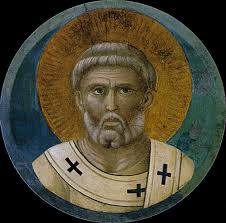Giotto was a Florentine painter, architect and sculpture of immense talent. As the artist who first broke free from the constraints of medieval and byzantine art, he’s considered the first genius of the Italian renaissance.
At the start of the 14th century, word of Giotto’s mastery reached Pope Benedict XI in Lombardy. The Pope sent a courtier to Florence to see who this Giotto was, with a view to commissioning some paintings for Saint Peter’s Basilica in the Vatican.
The courtier first travelled to Siena to collect designs from other masters. He then went to Giotto’s studio in Florence and asked for a drawing to take back to the Pope.
Giotto took a canvas, dipped his brush in red paint, pinned his arm to his side and drew a perfect circle with his hand. He grinned and said “Here’s your drawing”.
The courtier, feeling mocked, asked for another drawing. Giotto replied “This is enough, and more than enough.” Although he suspected that he was being taken for a ride, the courtier took Giotto’s drawing back to the Pope along with the other masters’ drawings.
The courtier explained how Giotto had drawn the circle unaided, and the Pope and his advisers realised just how much Giotto surpassed all the other painters of the era. Giotto got the job*.
Giotto’s proof of his masterpiece was his free-hand circle. It was a concise way for him to demonstrate his enormous technical skill. Watching him draw the circle, it probably looked easy, but undoubtedly it took years, if not decades, of practice to get that kind of lazy, deft skill.
Much of the business of software is a craft, and I suspect that every craft has its Giotto’s O. If you’re a software developer, tester, designer, marketeer or other professional in the business, how would you prove your mastery of your craft?
Is there an equivalent of Giotto’s O?
*This is also the origin of the Tuscan phrase “rounder than Giotto’s O”.
This is not a compliment – “round” means dim-witted in the local dialect.
Learn how great SaaS & software companies are run
We produce exceptional conferences & content that will help you build better products & companies.
Join our friendly list for event updates, ideas & inspiration.
